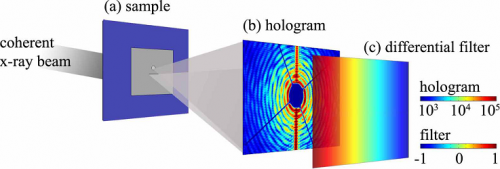The object and reference slit are illuminated by the coherent x-ray beam. (b) The hologram formed by the interference of the scattered x-rays from the object and reference slit is recorded on the CCD camera in the far field. (c) A linear differential filter, defined by the derivative of the slit direction, is multiplied by the hologram before performing a Fourier transform to retrieve the reconstructed image.
Impressive results from experiments at Diamond Light Source on magnetic lensless imaging by Fourier transform holography using extended references have been published today in Optics Express, the journal of the Optical Society of America.
Characterization of magnetic states on the submicron scale could lead to rapid advances in understanding and utilizing the properties of new materials for spintronic devices.
The work was conducted on the I06 Nanoscience beamline by a team of researchers from Diamond, Exeter, Grenoble and Leeds. Using a narrow slit milled through an opaque gold mask as a holographic reference, magnetic contrast of the magnetic sample is obtained by x-ray magnetic circular dichroism.
Fourier transform holography (FTH) is a well established lensless technique for imaging the perpendicular component of magnetic domains and systems with in-plane magnetization. The novel technique, known as holography with extended reference by autocorrelation linear differential operator (HERALDO), promises to be more efficient than standard Fourier transform holography, where small holes are used to define the reference beam. Generating increased intensity through the extended reference reduces the counting time to record the far-field diffraction pattern. Manufacturing the slits is also less technologically demanding than the current procedure.
"We are very pleased with these results, which show clear images of magnetic domains in a Co/Pt multilayer thin film with perpendicular magnetic anisotropy. We achieved a spatial resolution of ∼30 nm, and this was only limited by the sample period. By adjusting the experimental setup we hope to achieve 15 nm in the near future," said Professor Gerrit van der Laan, Senior Research Scientist at Diamond Light Source
The ability of this technique to directly image magnetic configurations within an applied field could help to advance magnetic logic and race track memory devices, which require an understanding the propagation and controlled pinning of magnetic domain walls along nanowires.
More information: Thomas A. Duckworth, et al., "Magnetic imaging by x-ray holography using extended references," Opt. Express 19, 16223-16228 (2011). www.opticsinfobase.org/oe/abst … m?URI=oe-19-17-16223
Provided by Diamond Light Source





















